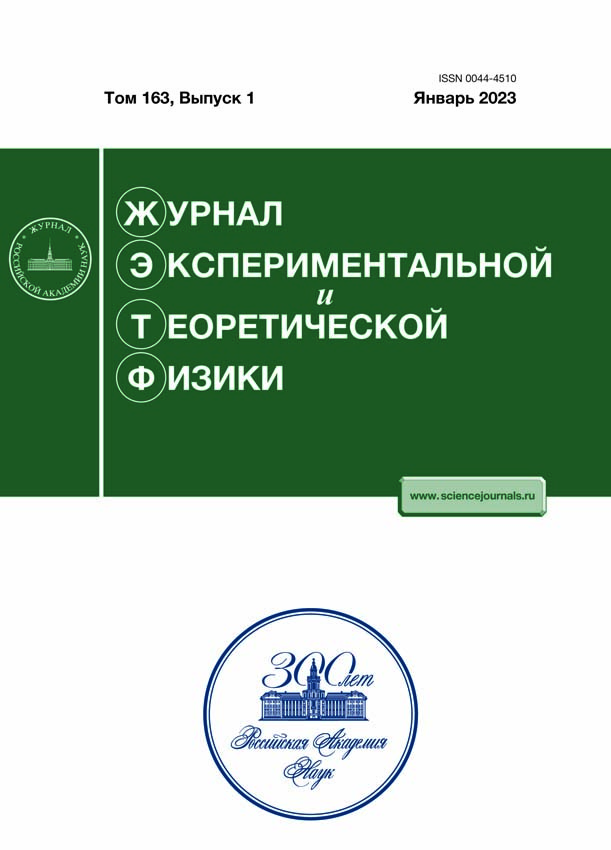Hall Effect in Magnetic Tunnel Junctions
- Авторлар: Karashtin E.A1, Gusev N.S1,2, Pashen'kin I.Y.1, Sapozhnikov M.V1,2, Fraerman A.A1
-
Мекемелер:
- Institute for Physics of Microstructures, Russian Academy of Sciences
- Lobachevsky Nizhny Novgorod State University
- Шығарылым: Том 163, № 1 (2023)
- Беттер: 5-13
- Бөлім: Articles
- URL: https://transsyst.ru/0044-4510/article/view/653571
- DOI: https://doi.org/10.31857/S0044451023010017
- EDN: https://elibrary.ru/NMMWGO
- ID: 653571
Дәйексөз келтіру
Аннотация
We have constructed a theory of the Hall effect appearing during the passage of current in a magnetic tunnel junction due to the spin–orbit interaction in an insulator barrier in the approximation of a delta-shaped barrier potential. Both the normal Hall current flowing in metal banks as a result of asymmetric scattering in the tunneling barrier and the anomalous current existing only in the tunneling barrier due to the presence of the spin–orbit interaction in it are taken into account. We have considered the Rashba interaction that can be of intrinsic origin (noncentrosymmetric form of the barrier) or can be induced by an extraneous electric field emerging as a result of application of a potential difference to the barrier. Such a field can reach a value on the order of 109 W/m, which is close to intrinsic atomic fields. The Hall current has both linear and quadratic components in the voltage applied to the tunnel junction. The existence of the nonlinear Hall voltage corresponding to it has been illustrated experimentally in a CoFeB/MgO/Pt tunnel junction, in which the transverse (Hall) voltage has been measured in the Pt layer.
Авторлар туралы
E. Karashtin
Institute for Physics of Microstructures, Russian Academy of Sciences
Email: eugenk@ipmras.ru
603950, Nizhny Novgorod, Russia
N. Gusev
Institute for Physics of Microstructures, Russian Academy of Sciences; Lobachevsky Nizhny Novgorod State University
Email: jetp@kapitza.ras.ru
603950, Nizhny Novgorod, Russia; 603950, Nizhny Novgorod, Russia
I. Pashen'kin
Institute for Physics of Microstructures, Russian Academy of Sciences
Email: jetp@kapitza.ras.ru
603950, Nizhny Novgorod, Russia
M. Sapozhnikov
Institute for Physics of Microstructures, Russian Academy of Sciences; Lobachevsky Nizhny Novgorod State University
Email: jetp@kapitza.ras.ru
603950, Nizhny Novgorod, Russia; 603950, Nizhny Novgorod, Russia
A. Fraerman
Institute for Physics of Microstructures, Russian Academy of Sciences
Хат алмасуға жауапты Автор.
Email: jetp@kapitza.ras.ru
603950, Nizhny Novgorod, Russia
Әдебиет тізімі
- N. Nagaosa, J. Sinova, S. Onoda, A. H. MacDonald, and N. P. Ong, Rev. Mod. Phys. 82, 1539 (2010).
- J. Sinova, S. O. Valenzuela, J. Wunderlich, C. H. Back, and T. Jungwirth, Rev. Mod. Phys. 87, 1213 (2015).
- S. A. Tarasenko, V. I. Perel′, and I. N. Yassievich, Phys. Rev. Lett. 93, 056601 (2004).
- A. Matos-Abiague and J. Fabian, Phys. Rev. Lett. 115, 056602 (2015).
- A. Vedyaev, N. Ryzhanova, N. Strelkov, and B. Dieny, Phys. Rev. Lett. 110, 247204 (2013).
- A. Vedyaev, N. Ryzhanova, N. Strelkov, M. Titova, M. Chshiev, B. Rodmacq, S. Au ret, L. Cuchet, L. Nistor, and B. Dieny, Phys. Rev. B 95, 064420 (2017).
- A. V. Vedyaev, M. S. Titova, N. V. Ryzhanova, M. Ye. Zhuravlev, and E. Y. Tsymbal, Appl. Phys. Lett. 103, 032406 (2013).
- С. В. Вонсовский, Магнетизм, Наука, Москва (1971).
- Л. Д. Ландау, Е. М. Лифшиц, Квантовая механика. Нерелятивистская теория, Наука, Москва (1989).
- A. M. Kriman, N. C. Kluksdahl, and D. K. Ferry, Phys. Rev. B 36, 5953 (1987).
- Е. А. Караштин, ФТТ 64, 1311 (2022).
- И. Ю. Пашенькин, М. В. Сапожников, Н. С. Гусев, В. В. Рогов, Д. А. Татарский, А. А. Фраерман, ЖТФ 89, 1732 (2019).
- E. A. Karashtin, J. Magn. Magn. Mater. 552, 169193 (2022).
- N. S. Gusev, A. V. Sadovnikov, S. A. Nikitov, M. V. Sapozhnikov, and O. G. Udalov, Phys. Rev. Lett. 124, 157202 (2020).
- A. Brataas, Y. Tserkovnyak, G. E. W. Bauer, and B. I. Halperin, Phys. Rev. B 66, 060404(R) (2002).
Қосымша файлдар









